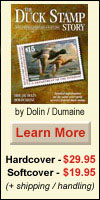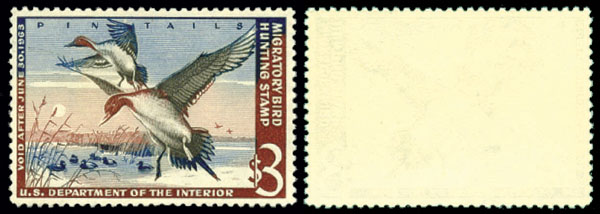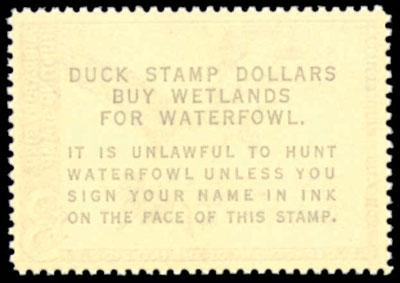 |
10% off on
web orders over $100 |
|
|

|
|
New $3 Pintail Drakes error found
A previously unreported major error of the United States $3 Pintail Drakes duck stamp of 1962 (Scott RW29) with back printing omitted came to light recently. The front and back of this new error, which the Philatelic Foundation certified in 1995, is illustrated in Figure 1. Figure 2 pictures the back of a normal Pintail Drakes stamp bearing the inscriptions: "Duck Stamp Dollars Buy Wetlands For Waterfowl. "It is unlawful to hunt waterfowl unless you sign your name in ink on the face of this stamp."
This is the only back-printing-omitted example reported to date for RW29, and only one other federal duck stamp is known with a similar error: the $12.50 Black-bellied Whistling Duck, Scott RW57a, issued in 1990. While several hundred RW57a errors exist, the RW29 error is unique, at least thus far.

The Pintail Drakes error resided in the collection of a New York area collector until his recent death. Virtually his entire collection had been sold through various sources, except some odds and ends that included the Pintail Drakes error, all of which was sold in an estate sale. An advanced collector who wishes to remain anonymous purchased the Pintail Drakes error stamp.
Missing or inverted back printing errors are rare. The nature of these errors makes them elusive, as nonspecialists may not be aware that a given stamp should have back printing, or that normal back printing is right side up in relation to the stamp design. A hunter would not think twice about affixing an error stamp of either issue to his license, but he might spot an error of color on the face of the stamp. Inverted back printing can be identified easily by looking at the face of the stamp upright, and then turning the stamp over as if you were flipping the page of a book. After turning the stamp, the back printing should be readable, as shown in Figure 2.
Federal duck stamps known with inverted back printing are the $2 Blue Geese (Scott RW22a), the $2 American Eiders (RW24a) and the $3 Labrador Retriever and Mallard Drake (RW26a). Beginning with the 1954 $2 Ring-necked Ducks (Scott RW21), back printing was placed on top of the gum, so a regummed stamp also would lack back printing. For this reason, it is recommended that stamps with back printing omitted be submitted to an expertizing service for authentication.
o
The annual U.S. federal duck stamp contest will be held Nov. 5-7 in the main auditorium of the Department of the Interior, 18th and C Streets N.W., Washington, D.C. The winning artist will be announced Nov. 7 and his artwork will appear on the 2002-03 duck stamp. This year's contest is a bit like those of the very early days, in that only one species was eligible, the black scoter. Ten years ago, however, the black scoter was part of a group of five species from which the artists could chose.
These groups of five species rotated every other year so that eventually every duck species would be shown on a U.S. duck stamp. Confused? Don't be. Let's assume, for example, that five species were in the contest one year, and artwork depicting species 2 was selected to be on a duck stamp. The next year, five different species would be in the contest. The following year, species 1, 3, 4 and 5 would be in the contest, plus a new species (13, say) to replace species 2, which won an earlier contest. Because the black scoter is not a very attractive bird - an ugly duckling, if you will - it was not selected under this rotating system and thus is the sole remaining species for this year's contest. About 10 years ago, a goal was established: depict all North American migratory waterfowl species that had not previously appeared on a federal duck stamp. When the 2002-03 stamp featuring the black scoter is issued, this goal will have been met.
As in past years, the annual meeting of the National Duck Stamp Collectors Society will take place immediately following the Nov. 7 announcement of the winner. The meeting will be held on the third floor of the Interior building. The meeting is usually short, about an hour, and it focuses on the society's business. Members and visitors are welcome. Terry Bell, acting chief of the federal duck stamp office, told me that 246 entries have been received. Because this year's event was a one-species contest, organizers were expecting only 50 to 75 entries, so the result has to be gratifying.
The contest originally was scheduled for one day, but it was expanded to three days as the number of entries swelled just prior to the Sept. 15, 2001, deadline. "Although there are not as many entries as most previous years," Bell said, "the overall quality is much higher, apparently due to the artists focusing on only one species. This year's judges will have a tough time selecting a winner." It was originally felt that the elusiveness of the black scoter, and its solid black color except for a yellow-orange protuberance at the base of the drake's bill, would diminish interest and entries.
In most previous contests, artists had three to five species from which to select. Also, because the black scoter lives on the extreme northern portions of the East and West coasts, including Alaska and Canada, many artists do not have a working model. The black scoter was last eligible in the 1999 contest (for the 2000-01 stamp), where it competed with the mottled duck. That year, only 243 entries were received, three less than this year.
Adam Grimm's mottled duck art won the 1999 contest, and Terry Doughty finished second with his black scoters entry. You have to go back to the 1971 contest to find fewer entries, when 213 were submitted. The highest number of entries - 2,099 - was received in 1981, when David Maass won. Several artists I spoke with applauded the single-species concept. Many stated it would allow the best art to win, rather than the best looking duck picture. Comparing entries depicting one species will allow judges to pinpoint and analyze specifics about the art for its own merit rather than comparing the relative beauty of different species.
--------------------------------------------------------------------------------

Figure 1. The back printing on this $3 Pintail Drakes duck stamp, left, is missing, as shown at right. The newly reported error was certified by the Philatelic Foundation in 1995.
--------------------------------------------------------------------------------

Figure 2. Back of a normal $3 Pintail Drakes stamp, showing the back printing
|
|
|



















